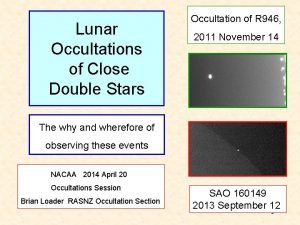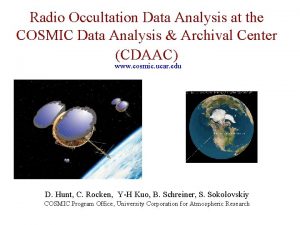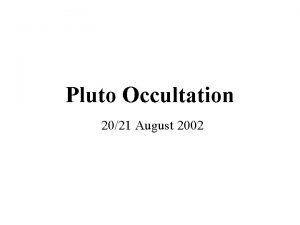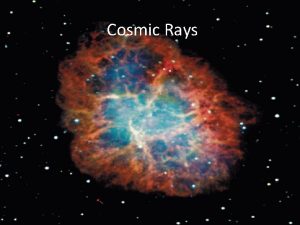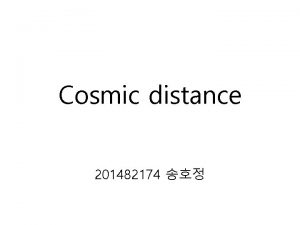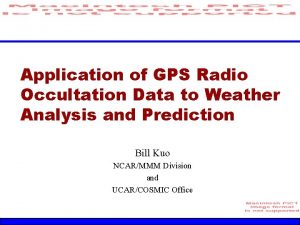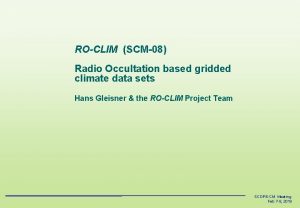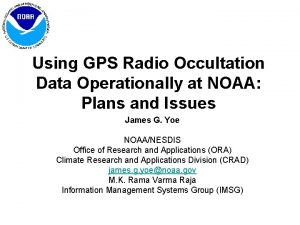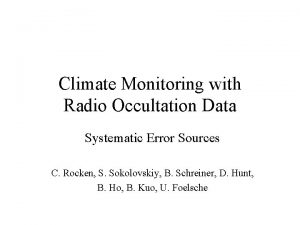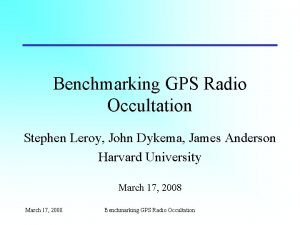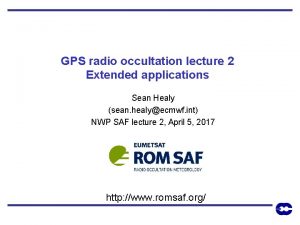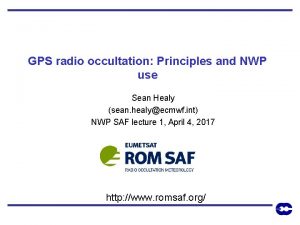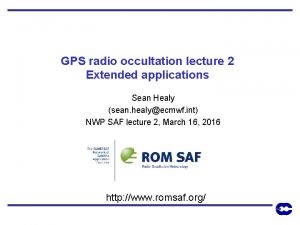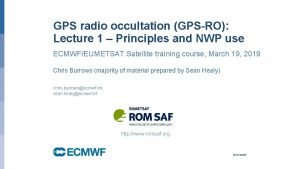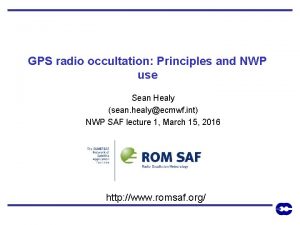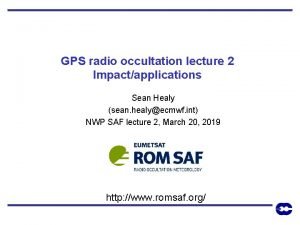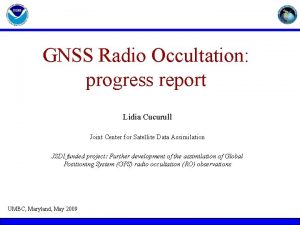Radio Occultation Data Analysis at the COSMIC Data




































- Slides: 36

Radio Occultation Data Analysis at the COSMIC Data Analysis & Archival Center (CDAAC) www. cosmic. ucar. edu D. Hunt, C. Rocken, Y-H Kuo, B. Schreiner, S. Sokolovskiy COSMIC Program Office, University Corporation for Atmospheric Research

Overview COSMIC Description CDAAC data processing and data formats Successes Challenges CDAAC 'Live' demo

COSMIC at a Glance

COSMIC Launch

COSMIC Occultation Distribution Earth-fixed Frame Sun-fixed Frame COSMIC EQUARS Radiosondes

T 1 LAN Payload Commands and All Real-Time Data Products S/C Telemetry T 1 Internet S band L band COSMIC System

COSMIC Spacecraft Orbital Science’s ORBCOM s/c bus Mass ~ 70 kg, Size ~ 1 m diameter Propulsion: orbit insertion, maintenance, de-orbiting Attitude: ● Control: 2 deg pitch, 5 deg roll/yaw (2 -sigma) ● Knowledge: 1 deg pitch, 2 deg roll/yaw Nadir orientation, 3 -axis stabilized 40 MB on-orbit storage

COSMIC Payloads Each COSMIC satellite will carry 3 complementary payloads ● GPS - for atmospheric/ionospheric profiling and scintillation » JPL Heritage design ● Tiny Ionospheric Photometer (TIP) for F 2 layer electron density mapping » NRL Heritage design ● Tri-band beacon (CERTO/TBB) for high-resolution ionospheric imaging and scintillation studies » NRL Heritage design

COSMIC GPS Receiver: ARGO JPL Design, ARGO is based on CHAMP Black. Jack Receiver Technology transfer JPL -> Broad Reach Engineering 4 antennas: 2 occultation + 2 POD antennas Receiver + Data Recorder/PC: 3. 5 kg Power ~16 W GPS + 10 W Data Recorder/PC New “open loop” tracking and software for rising occultations under development at JPL

COSMIC Data Analysis and Archival Center (CDAAC)

CDAAC Responsibilities Process all COSMIC observations ● ● LEO/GPS orbit determination Atmospheric & Ionospheric profiles Rapid analysis for operational demonstration Post-processed analysis for climate and other research Provide data to universities and research laboratories Provide data feeds (< 3 hr) to operational centers Archive data & provide web interface

CDAAC Processing Flow Atmospheric processing LEO data Level 0 --level 1 Fiducial data Orbits and clocks Excess Phase Canonic Transform Abel Inversion 1 -D Var Moisture Correction Real time Task Scheduling Software Profiles Ionospheric processing Excess Phase Abel Inversion Combination with other data Current processing time for 35 occultations + 100 minutes of fid data: 9 min

GPS Data Processing - GPS Orbits/ERP (Final/IGU) - Station Coordinates - 30 -sec Ground GPS Obs. - 1 -Hz Ground GPS Obs. - 50 -Hz LEO Occultation GPS Obs.

LEO POD Quality CHAMP-B (EIGEN-S 1) minus CHAMP-A (EGM 96) Temperature profiles

Calibration of excess phase delay Single Difference ● LEO clock errors removed ● use solved-for GPS clocks ● Main advantage: Minimizes double difference errors

Inversion Details

CDAAC Hardware Currently consists of one Linux Beowulf style cluster ● Myrinet high speed interconnect ● 1 Terrabyte RAID, NFS mounted from master node ● Dual 2. 0 GHz Pentium 4 Xeon cluster nodes ● One node dedicated to post-processing ● One or more nodes dedicated to real time processing Archival using NCAR mass store ● 1. 0 petabyte tape farm

CDAAC Software written in perl, C or FORTRAN Currently consists of around 100 separate packages: ● CVS modules for source developed at UCAR ● open source packages: » » apache postgres perl modules ● Commercial packages » Bernese » F 90 compiler Includes install system for easy compilation and testing on a basic Linux system

CDAAC post processing Done for climate and archival purposes Run on one node from one top level script 30 -60 day latency for current CHAMP processing Run by hand by an operator Uses: ● better orbits, ● more GPS ground station data ● Gridded analysis instead of prediction Done in day-long batches, instead of by LEO download

CDAAC real-time processing Run automatically as data are received on one or more cluster nodes Currently processing CHAMP data with 12 -24 hour latency Results are currently generated on average 45 minutes after receipt of CHAMP level 0 data ● We expect to tune this to < 20 minutes for COSMIC Uses predicted GPS orbits and forecast weather grids Designed to allow processing of multiple missions (CHAMP, SAC-C, COSMIC, etc) on the same cluster of machines at the same time Processing controlled by three perl daemons: ● Queue daemon (one per cluster) ● Master daemon (one per mission)

Realtime processing (cont. ) Master daemon FTP processes Users File Queue Job Queue FTP, LDM, other? Slave daemons Files on disk CDAAC web Processing jobs Database

Question: How to deliver data How to deliver occulation files? ● BUFR format occultation files to NESDIS » FTP? » HTTP? » Unidata LDM? » Other? ● Full resolution data from CDAAC » FTP? » LDM? » Web?

File Formats Standard level 1 a formats defined for all missions Standards used include: ● Bernese ASCII formats ● UCAR BINEX for GPS data ● SP 3 orbits High level (level 1 b and 2) files are standard format Net. CDF ● Uniformly accessible by libraries of database and statistics software ● Web tools Details of data formats on www. cosmic. ucar. edu (click on 'analysis data', then on 'file formats').

BUFR format ■ Compact binary ■ Multiple profile variables ● Time vs. Excess phase, satellite position ● Height vs. Bending angle, impact parameter » NOT time vs bending angle. ● Height vs. refractivity ● Height vs. pressure/temperature/moisture ■ Low resolution (~200 levels for each profile) ● Is this enough for assimilation?

BUFR format issues ■ Working with Dave Offiler on these issues ■ CDAAC can only deliver bending angle, impact parameter and perigee lat/lon vs. height, not vs. time ● limitation of radio holographic methods ■ Quality flags may need to be worked out. ✔ Occultation ID needs more flexibility than a single number ✔ Need to add a LEO ID for multiple LEO missions

Successes

Validation Statistics with NCEP CHAMP Global SAC-C (Comparisons to NCEP-NCAR Global Re-analyses (6 hr, 28 sigma levels, 1. 87 deg longitude, 94 gaussian latitudes, ds 090. 0)

ROSE Refractivity Comparisons GFZ UCAR JPL Common set of over 1500 CHAMP occultations compared Three centers participated: ● UCAR ● JPL ● GFZ

Tailored experiments with predicted occultations Drop sonde launched on day 2003. 143 near Taiwan Dropped to match a predicted CHAMP occultation Good agreement for both moisture and temperature

COSMIC Challenges

Inversion Q/C: CHAMP 2002. 213 -243 Reasons for Inversion Failure -- Aug 2002 Of 8071 total occultations tracked and with fiducial and reference data: ● 1303 Failed calibration (no excess phase file generated) ● Inversion Failures: » 989 Occultation starts too low » 415 Failed difmaxref (climatology refractivity check) » 159 Failed s 4 (scintillation on occulting link) » 52 Failed difmaxion (max L 1, L 2 bending angle check) » 44 Occultation ends too high » 42 Problem in Canonic Transform method » 26 Z, N, P or T fails sanity check » 10 Failed smean (bias WRT climatology bending angles)

Clock distribution problems L 1 L 2 Effect of L 4 (L 1 -L 2) smoothing

L 2 signal noise, SAC-C

Extrapolation of Ionospheric Correction to process occultations with noisy L 2 Dec 2001, SAC-C Without correction With correction

Super-refraction, Ducting Near St. Helena Is.

Summary COSMIC program on track for 2005 launch: satellites are built at Orbital, GPS at Broad Reach, TIB + Beacon at NRL CHAMP and SAC-C processing up-to-date Near-real time processing, ~1 day latency for CHAMP data ~ 70 -80% of calibrated occultations are inverted successfully (2002. 213 -243) Good agreement between CHAMP and SAC-C Good agreement with NCEP/ECMWF Comparisons between GFZ/JPL/UCAR successful Ongoing work on data delivery to weather centers (formats, protocols) Web page: www. comic. ucar. edu
 Double occultation
Double occultation Trunking vs conventional radio system
Trunking vs conventional radio system Hình ảnh bộ gõ cơ thể búng tay
Hình ảnh bộ gõ cơ thể búng tay Lp html
Lp html Bổ thể
Bổ thể Tỉ lệ cơ thể trẻ em
Tỉ lệ cơ thể trẻ em Gấu đi như thế nào
Gấu đi như thế nào Tư thế worm breton là gì
Tư thế worm breton là gì Bài hát chúa yêu trần thế alleluia
Bài hát chúa yêu trần thế alleluia Các môn thể thao bắt đầu bằng tiếng bóng
Các môn thể thao bắt đầu bằng tiếng bóng Thế nào là hệ số cao nhất
Thế nào là hệ số cao nhất Các châu lục và đại dương trên thế giới
Các châu lục và đại dương trên thế giới Công thức tiính động năng
Công thức tiính động năng Trời xanh đây là của chúng ta thể thơ
Trời xanh đây là của chúng ta thể thơ Cách giải mật thư tọa độ
Cách giải mật thư tọa độ Làm thế nào để 102-1=99
Làm thế nào để 102-1=99 độ dài liên kết
độ dài liên kết Các châu lục và đại dương trên thế giới
Các châu lục và đại dương trên thế giới Thơ thất ngôn tứ tuyệt đường luật
Thơ thất ngôn tứ tuyệt đường luật Quá trình desamine hóa có thể tạo ra
Quá trình desamine hóa có thể tạo ra Một số thể thơ truyền thống
Một số thể thơ truyền thống Cái miệng nó xinh thế
Cái miệng nó xinh thế Vẽ hình chiếu vuông góc của vật thể sau
Vẽ hình chiếu vuông góc của vật thể sau Nguyên nhân của sự mỏi cơ sinh 8
Nguyên nhân của sự mỏi cơ sinh 8 đặc điểm cơ thể của người tối cổ
đặc điểm cơ thể của người tối cổ Thế nào là giọng cùng tên? *
Thế nào là giọng cùng tên? * Vẽ hình chiếu đứng bằng cạnh của vật thể
Vẽ hình chiếu đứng bằng cạnh của vật thể Tia chieu sa te
Tia chieu sa te Thẻ vin
Thẻ vin đại từ thay thế
đại từ thay thế điện thế nghỉ
điện thế nghỉ Tư thế ngồi viết
Tư thế ngồi viết Diễn thế sinh thái là
Diễn thế sinh thái là Dot
Dot Các số nguyên tố là gì
Các số nguyên tố là gì Tư thế ngồi viết
Tư thế ngồi viết Lời thề hippocrates
Lời thề hippocrates
